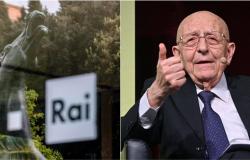Four exhibition projects part of Milan Art Week, a bubbling Milanese cauldron “dedicated to contemporary art and languages”, inaugurated on April 10th at the Museo del Novecento. Week in which everything inaugurates, opens and happens, from micro to macro, then paving the way for the Salone del Mobile and then gradually straight towards the Venice Biennale. Three of these are works conceived and created for the museum spaces by contemporary and very living artists. The Cypriot Haris Epaminonda (what a wonderful name!) installs in the gallery of Futurism, a movement of which the Museo del Novecento is the Milanese home, having then all started with that brawl in the gallery which the Palazzo dell’Arengario overlooks today, a reflection on those bold people who wanted to sing the love of danger but above all on the more elusive figure of Medardo Rosso, who the futurists magnified but who was never organic to the movement.
Going up you meet Off Script, by Dutch artist Magali Reus, with moments of pop nostalgia that take the form of oversized, finished and dripped jars of jam hanging on the walls. One floor up and you come across City portrait (20/20.000Hz)a large multi-channel video-installation of primary chic and compositional elegance, between silence and noise and city and architecture, Luciano Berio and the Phonology Studio of the RAI in Milan, which arouses curiosity and makes you want to know all these stories and read more , and to go out and look at the Velasca Tower with new eyes for the millionth time and to learn more about BBPR for example, or even just to look around and study carefully all the work of Italo Rota who designed the spaces of the Museo del Novecento where we are and who died just a few days ago.
What excites and makes you lose the sense of time, however, is the last large room, in which the ARCHIVE_001. From 1940 to today – Snapshots from the art galleries of Milan, edited by Mariuccia Casadio who together with her niece Dora Casadio has collected and put together documents, photographs, invitations, articles, magazines, catalogs and offal of eighty years of art passed through the city’s galleries: «A diachronic journey, made of impressions, references, connections, ancestry and descent”, says the press kit, and in fact this is the case. A shuffling of the documents saved from the archives which here seem to regain their breath and their place, on the walls as in the display cases, putting themselves back together on their own without the hindrance of chronology or priority or even just the theme.
A carefully prepared chaos that becomes a great game of Memory in which a caption refers to a catalog that refers to a photo that recalls a text and then you go back and reread it and let yourself be fascinated and then something else recalls the pay attention and then you get lost and then off again from the beginning and virtually to infinity. What the experience returns is a fervor, a swarming, a vibration of almost a century of Milan which through its galleries has been and perhaps still knows how to be even if it probably could be better, as described by Pierre Restany who in 1972 wrote: «The tradition of the Milanese does not consist in conserving, but in predicting. And if the taste for innovation sometimes manifests itself in an abusive way, this excess simply translates the state of mind of an active, dynamic population, decidedly oriented towards the future”.
And then you find photos of Carla Pellegrini sitting on a furni-fetish chair by Allen Jones next to that of an exhausted Massimo De Carlo squashed against the wall with packing tape by Maurizio Cattelan. And the magazines of the Galleria del Milione, and the flyer for an exhibition of Pinot Gallizio, and the hammer and sickle of Enzo Mari, and Keith Haring, and Urs Luthi, and Robert Longo in 1980 with hair even crazier than the ones that today he’s chatting with a very young Helena Kontova. There is Hermann Nitsch slicing a fish in 2000 at Enzo Cannaviello and there is the very elegant Luciano Inga Pin. There is everything that private galleries have been, have done, which certainly includes a lot of money, and could still be and give to anyone who overcomes that sense of inadequacy that one often feels when crossing the threshold.
Whether this happens little, and it happens little especially in Milan compared to other large cities, out of modesty or snobbery is an open question. But reviewing all this material together makes you think that here too there was no joking at all, and indeed what a great century it was. And maybe you want to shake up that system a little, and be part of it, not caring about modesty or snobbery. Because, as Casadio says «galleries should not be luxury boutiques or impregnable spaces, they should be like that bar or that nightclub where you feel at your place, that if you are out and about and it rains, you can go in and see a nice exhibition, which is told to you well, and sit down to drink tea.”





